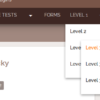How to Convert Grayscale Shades/Tints to Their Color Equivalents

For the lack of a better title, what I mean here is, say you have black as your darkest color for design A, and a maroon as the darkest color for design B.

For the lack of a better title, what I mean here is, say you have black as your darkest color for design A, and a maroon as the darkest color for design B.

While customizing my new Arch and Openbox setup, I was generating menus with menumaker, but I wanted at least the Applications part of my menu to update as soon as new applications are installed. So, I needed an application specific pipe menu to fulfill this purpose.

Okay, so this is a continuation of a previously written tutorial, Hiding and Showing a WordPress Menu on Mobile Devices. In that tutorial, I described how to create a JS controlled dropdown menu that turns into a button in mobile devices.

In the course of updating Urban Square, I noticed the theme’s high definition background did not match with the options for WordPress’s built in custom background feature.

I know, I know. Right off the bat, developers will ask you why wouldn’t you use an existing CSS parser and integrate it into your projects? If you are creating a more limited use
Recently, I added a menu feature to the theme for this website as well as for Urban Square awhile back. The feature is a button that hides and shows a menu specifically designed for a mobile phone. The same menu would be used for the desktop layout, but styled differently for the mobile phone.